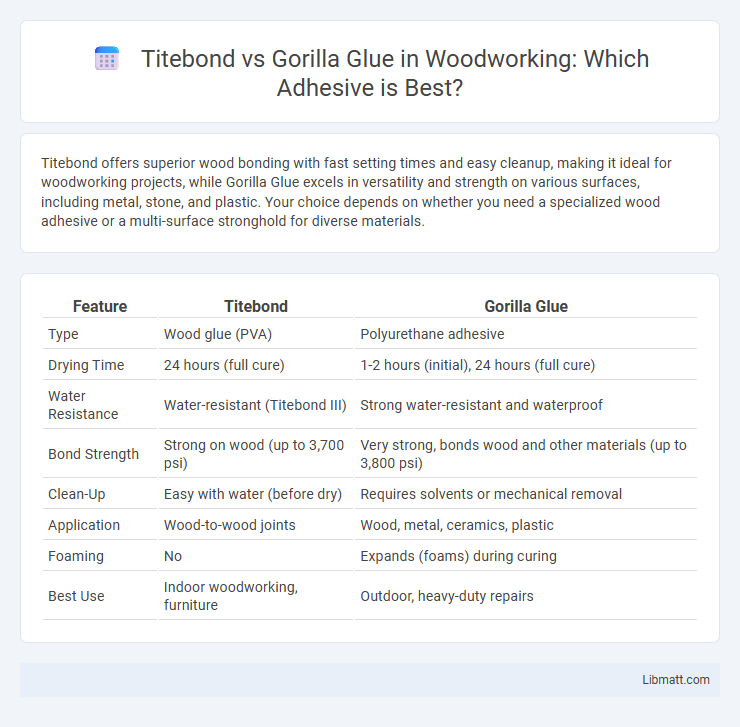Titebond offers superior wood bonding with fast setting times and easy cleanup, making it ideal for woodworking projects, while Gorilla Glue excels in versatility and strength on various surfaces, including metal, stone, and plastic. Your choice depends on whether you need a specialized wood adhesive or a multi-surface stronghold for diverse materials.
Table of Comparison
| Feature | Titebond | Gorilla Glue |
|---|---|---|
| Type | Wood glue (PVA) | Polyurethane adhesive |
| Drying Time | 24 hours (full cure) | 1-2 hours (initial), 24 hours (full cure) |
| Water Resistance | Water-resistant (Titebond III) | Strong water-resistant and waterproof |
| Bond Strength | Strong on wood (up to 3,700 psi) | Very strong, bonds wood and other materials (up to 3,800 psi) |
| Clean-Up | Easy with water (before dry) | Requires solvents or mechanical removal |
| Application | Wood-to-wood joints | Wood, metal, ceramics, plastic |
| Foaming | No | Expands (foams) during curing |
| Best Use | Indoor woodworking, furniture | Outdoor, heavy-duty repairs |
Introduction to Titebond and Gorilla Glue
Titebond is a trusted brand known for its versatile wood glues that provide strong, fast-setting bonds ideal for woodworking and carpentry projects. Gorilla Glue offers a range of polyurethane-based adhesives celebrated for their exceptional strength, water resistance, and ability to bond diverse materials such as wood, metal, ceramic, and plastic. Both brands deliver high-performance adhesive solutions tailored to professional and DIY applications, with Titebond specializing in wood bonding and Gorilla Glue excelling in multi-surface durability.
Key Differences Between Titebond and Gorilla Glue
Titebond offers superior wood glue formulas with fast-setting capabilities and easy water cleanup, making it ideal for woodworking projects requiring quick assembly and strong, sandable bonds. Gorilla Glue excels as a polyurethane adhesive, providing exceptional versatility with its waterproof, expanding foam that bonds wood, metal, ceramic, and more, though it requires moisture activation and careful application to avoid excess expansion. Your choice should depend on the materials involved and the specific strength and drying requirements of your project.
Composition and Chemical Properties
Titebond is primarily a polyvinyl acetate (PVA) adhesive known for its water-based, non-toxic composition, which makes it ideal for woodworking and indoor applications. Gorilla Glue, on the other hand, is a polyurethane adhesive characterized by its moisture-curing properties that create a strong, waterproof bond suitable for various materials, including wood, metal, and plastic. Understanding these chemical differences helps you select the right glue based on the material and environmental conditions of your project.
Bond Strength and Durability
Titebond offers superior bond strength on wood surfaces, reaching up to 3,280 PSI, making it ideal for woodworking and carpentry projects requiring strong, long-lasting joints. Gorilla Glue provides a versatile bond strength of about 1,300 PSI on various materials, excelling in durability and water resistance with its polyurethane formula. Both adhesives deliver excellent durability, but Titebond is preferred for wood bonding while Gorilla Glue is favored for multi-surface applications and outdoor use.
Application Methods and Ease of Use
Titebond offers easy application with its squeeze bottle design, allowing precise control and minimal mess for woodworking projects. Gorilla Glue requires moisture activation and expansion during curing, necessitating clamping and careful application to avoid excess foam. Woodworkers often prefer Titebond for faster assembly, while Gorilla Glue excels in bonding diverse materials but demands more attention to preparation and cleanup.
Drying Time and Curing Process
Titebond wood glue typically dries to the touch within 30 minutes and reaches full curing strength in 24 hours, making it ideal for woodworking projects requiring quick assembly. Gorilla Glue requires a longer curing time of 1 to 2 hours to set and up to 24 hours for a full cure, as it relies on moisture activation for a strong bond on diverse materials. Choosing between the two depends on your project's timeline and material types, with Titebond excelling in rapid wood bonding and Gorilla Glue offering versatility with extended drying and curing phases.
Water Resistance and Weatherproofing
Titebond offers moderate water resistance and is ideal for indoor woodworking projects where occasional moisture exposure occurs, but it is not fully waterproof. Gorilla Glue provides superior water resistance with a polyurethane-based formula that expands and bonds strongly, making it highly weatherproof and suitable for outdoor applications. For tasks requiring durable, weatherproof bonds exposed to rain or humidity, Gorilla Glue is the more reliable choice.
Versatility and Material Compatibility
Titebond offers superior versatility with formulations designed for wood, metal, and certain plastics, making it ideal for woodworking and general repairs. Gorilla Glue excels in bonding a wider range of materials, including ceramics, metal, wood, foam, glass, and more, providing a strong and waterproof bond. Your choice depends on the specific materials involved; Titebond is preferred for wood projects, while Gorilla Glue delivers more flexible compatibility across diverse surfaces.
Cost Comparison and Value for Money
Titebond offers a more affordable price point for woodworking projects, making it a cost-effective choice for frequent use. Gorilla Glue, while pricier, provides superior bonding strength and versatility, which delivers greater value for heavy-duty applications. Your best option depends on the balance between budget constraints and the required adhesive performance.
Which Glue Should You Choose?
Titebond and Gorilla Glue offer distinct advantages depending on your project needs; Titebond excels in wood bonding with fast drying and strong initial tack, ideal for furniture and carpentry work. Gorilla Glue's polyurethane formula provides superior water resistance and versatility on various materials, making it well-suited for outdoor and heavy-duty repairs. You should choose Titebond for precision woodworking and Gorilla Glue for durable, weather-resistant applications.
Titebond vs gorilla glue Infographic

 libmatt.com
libmatt.com